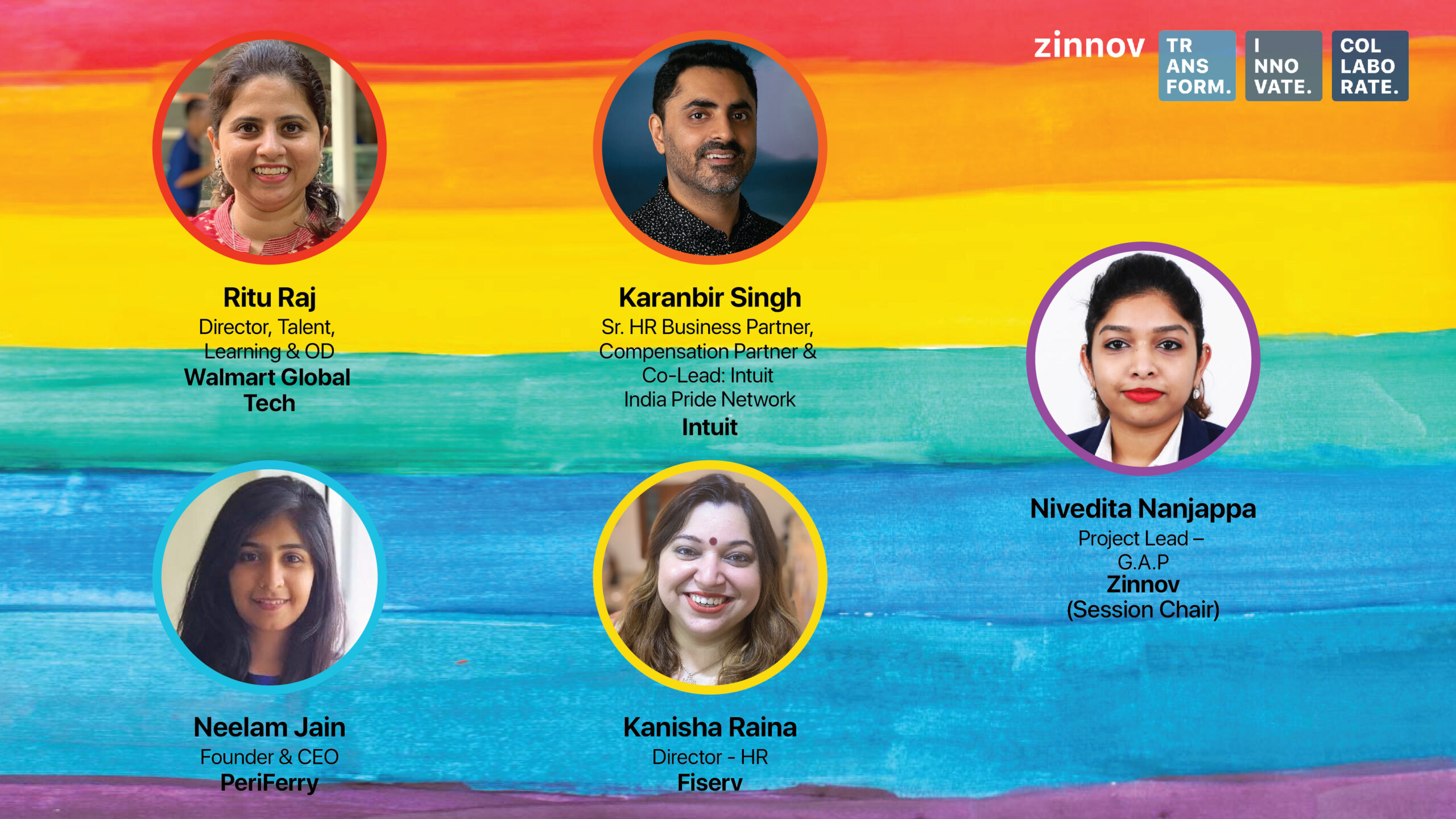|
|
While no one has been left unscathed by the pandemic, the Lesbian, Gay, Bisexual, Transgender, Queer (LGBTQ+) community has faced a double-edged sword of exacerbated poverty as well as heightened discrimination at healthcare centers. LGBTQ+ employees have experienced a higher rate of COVID-related job loss – 56% vs. 44% for majority – and a higher rate of neglect and abuse.
India Inc. is slowly realizing that the case for LGBTQ+ inclusion is stronger than ever, but tackling underrepresentation, stereotypes, and biases remain a work-in-progress. As Pride Month comes to a close, the question on all our minds remains: How can we advocate for the LGBTQIA+ Community, not just in June, but all year round?
At Zinnov’s quarterly Inclusion & Diversity (I&D) forum, we sat down with four experts to break down the role that organizations can play in shaping a truly queer-inclusive working world. Over the course of an hour, the panelists explored the key challenges of LGBTQ+ employees, their need-of-the-hour, the role of leadership and workforce allies in delivering outcomes, and the best possible approach to liberate the community at the grassroots.

The edited highlights below can serve as a reference guide to all organizations embarking on their journey to LGBTQ+ inclusion.
The first 90 days of an organization’s inclusion journey are the most important to gain momentum, identify role models, mobilize supporters, and set the foundation for long-term impact. Remember that basic steps integrated into regular habits will be what helps keep inclusion at the top of the agenda while juggling business needs.
The need-of-the-hour is to:
At Walmart, they hold sensitization sessions with not only their leadership and workforce, but also their support staff – security guards and cleaning crew alike. This spreading of awareness amongst all kinds of Walmart associates has been an eye-opening experience for Walmart I&D Leaders.
Employees base their actions on that of their leaders; hence, leaders have to be the pioneers/champions for any Inclusion agenda to be successful.
Especially for a marginalized community, having a relatable, successful role model within the workforce can be life changing. It is very important for people from the LGBTQ+ community at executive levels to muster the courage to come out to their workforce so they can be a huge positive influence.
The misconception that business meetings and inclusion conversations are mutually exclusive needs to be eliminated. Inclusion permeates all workplace interactions and leaders need to be held accountable accordingly.
Be it providing rainbow lanyards or virtual allyship badges, the little things do matter.
Back in 2017, when the Intuit team began its process of trying to outline inclusive policies for employees, they struggled with updating their existing contracts. Vendors were not being as accommodating as they had hoped, and they did not have the advantage of large headcount numbers to sway them. Here, the leaders took a firm stand to prioritize queer-inclusion, no matter what that would take, and that eventually influenced their insurance provider to cater to their needs.
Fiserv followed a two-pronged approach – the team developed a “Forward Together” strategy along with launching an Inclusive Leadership (Assessment & Coaching) Program for all managers across the globe. That initiative solidified their commitment to Inclusion.
Engaging Externally
Fostering Partnerships
Building Capabilities
“We need to pace the journey on queer enablement and empowerment; learnings from women empowerment efforts can serve as starting point towards building that momentum. As we have learnt, social awareness and financial stability are key to upliftment; and that starts with partnerships across the ecosystem towards skill building and creating employment opportunities.”
– Ritu Raj
“We need to incorporate as much diversity in our approach of working and addressing the problem, as we say we do in our talent strategies.”
– Neelam Jain
PeriFerry’s approach has been to not only prepare trans people for the workplace but to co-create workspaces that are truly inclusive and nurturing towards the LGBT+ community. The start-up has created jobs for over 205+ transgender persons, enabled 60+ corporate journeys, and has successfully sensitized over 22,000+ corporate India employees.
An ally, quite simply, can be anyone whose heart is in the right place – a good listener, eager to learn and engage, and committed to the LGBTQ+ cause. Allies are the single biggest factor that can transform a workplace.
“Please remember – you don’t need to be an expert to be an advocate.”
– Karanbir Singh
Expectations of an Ally
Challenges faced by Allies
Measuring success of Allyship Initiatives
Be open to the fact that identifying as part of the community is not restricted to professionalism, but rather all aspects of your personal life. A family member, friend or neighbor could be a part of the LGBTQ+ community as much as a colleague could.
Being an ally takes patience and persistence. Passionate individuals may become restless to see immediate outcomes, but do not lose heart. Acknowledge that good things take time – so, stick with it, show proof of work, and gratification will follow.
Interpret openly, listen deeply, and welcome discomfort.
Always have the attitude of doing more, to be more.
“Selfishly, becoming an ally was an opportunity to become a better version of myself – i.e., more effective at work and more emotionally balanced in life – because of the knowledge and wisdom I have gained throughout this sensitization journey. That should be the starting point for everyone to want to become an ally, if nothing else.”
– Kanisha Raina
Okay, you changed your logo and pledged support with Pride hashtags…what next?
When it comes to true Inclusion, everyday interactions with peers and leaders matter as much as organizational policies or formal processes. To make meaningful progress for LGBTQ+ employees, organizations can start with a few basics:
“When a flower doesn’t bloom, you fix the environment in which it grows, not the flower,” said Alexander Den Heijer. As organizations, we are responsible for fixing that environment for the LGBTQ+ community.
So, what are we waiting for?